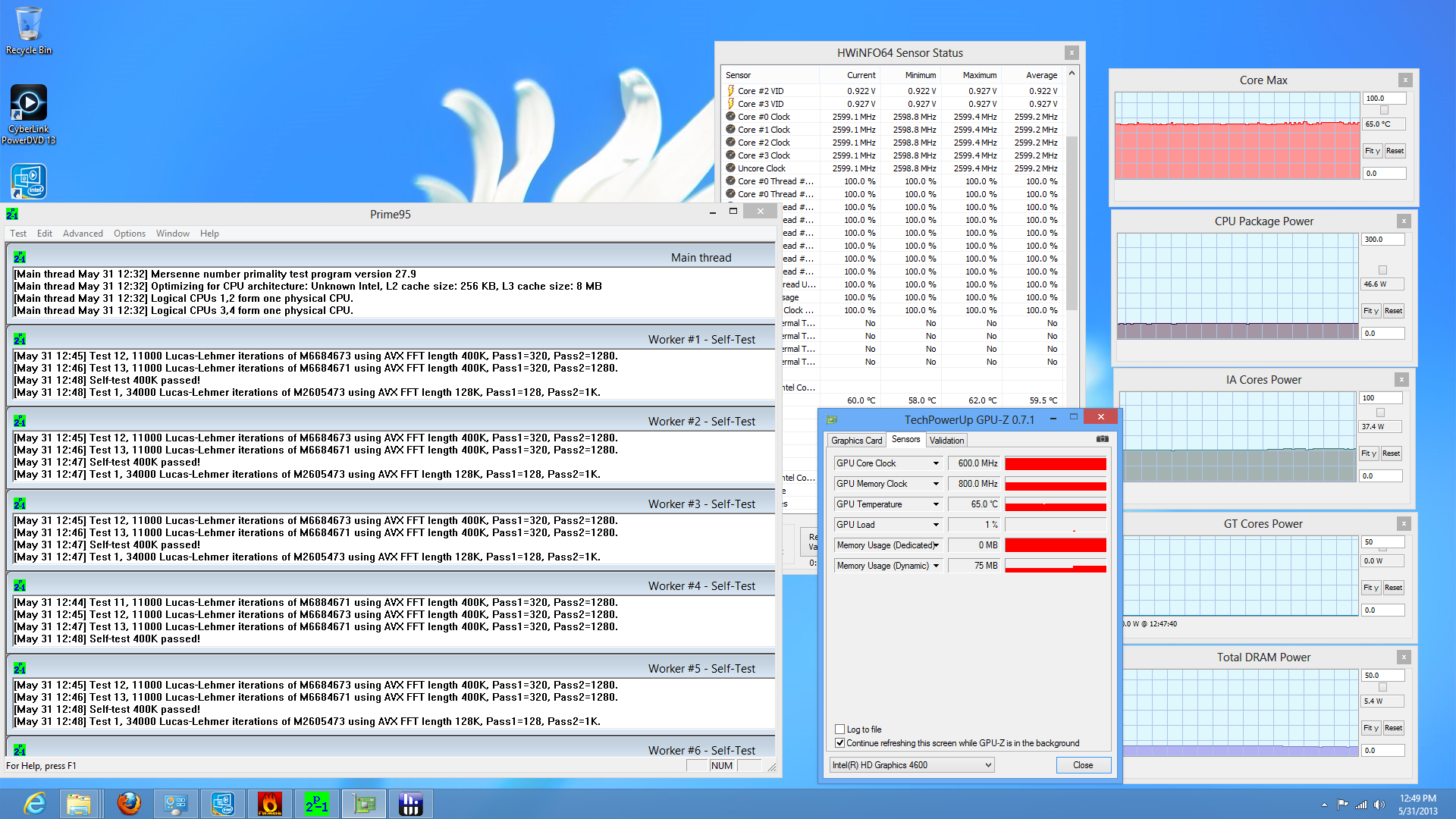Intel's Haswell - An HTPC Perspective: Media Playback, 4K and QuickSync Evaluated
by Ganesh T S on June 2, 2013 8:15 PM ESTPower Consumption
Before proceeding to the business end of the review, let us take a look at some power consumption numbers. The G.Skill RAM was set to DDR3 1600 during the measurements. We measured the average power drawn at the wall under different conditions. In the table below, the Blu-ray movie from the optical disk was played using CyberLink PowerDVD 13. The ISOs were mounted using Windows 8's in-built mounting tool. Prime95 v27.9 and Furmark v1.10.6 were used for stress testing. Blu-ray ISO ripping was done using AnyDVD HD v7.2. The Prime95 + Furmark benchmark was run for 1 hour before any measurements were taken. Power consumption numbers for local file playback using various renderer / decode combinations has already been covered in a previous section. The testbed was connected to a Wi-Fi network (and the GbE port was left unconnected) throughout the evaluation. In all cases, a wireless keyboard and mouse were connected to the testbed.
| Haswell HTPC Testbed Power Consumption | |
| Idle | 25.94 W |
| Sleep | 1.38 W |
| Prime95 v27.9 + Furmark 1.10.6 (Full loading of both CPU and GPU) | 85.68 W |
| Prime95 v27.9 (Full loading of CPU only) | 73.79 W |
| 1080p24 H.264 Blu-ray Playback from ODD | 34.5 W |
| 1080p24 VC-1 Blu-ray Playback from ODD | 33.21 W |
| 1080i60 VC-1 Blu-ray Playback from ODD | 34.37 W |
| 1080p24 VC-1 Blu-ray ISO Streaming from NAS | 30.91 W |
| 1080p24 H.264 MVC Blu-ray ISO Streaming from NAS | 32.67 W |
| Blu-ray Rip to ISO from ODD | 36.41 W |
The following screenshots gives an idea of how the integrated GPU and the CPU share the thermal headroom. In the first case, we have full CPU loading and no load on the GPU.
The CPU package power is around 47 W, with the IA cores alone consuming around 37 W. The second screenshot shows the transition from purely full CPU loading to full CPU and GPU loading. The CPU package power rises from 47 W to around 54 W. The GPU is consuming around 18 W, while the IA cores go down to around 27 W.











95 Comments
View All Comments
ganeshts - Monday, June 3, 2013 - link
Haven't come across a 4Kp60 sample yet. All the stuff on YouTube is at a max. of 30 fps, and I have some samples sourced from other platforms that are QuadFHD at 30 fps. Please pass on any 4Kp60 clips that you have.I know there are two crazy scene encodes with 4Kp50 (Crowd Run 2160p) and a 250 Mbps one (Ducks Take Off). No hardware decoder I have seen has been able to handle either properly. So, I doubt 4Kp60 is going to work :| That said, if I get a chance, I will definitely evaluate the Iris / Iris Pro.
madwolfa - Monday, June 3, 2013 - link
Why do you still need 23.96 support since "Smooth Motion" feature in MadVR? I couldn't care less now...Dug - Monday, June 3, 2013 - link
Because not everyone can, wants to, or even knows what MadVR is. Never mind setting it up properly.HOSH - Monday, June 3, 2013 - link
Personally this is going in the right direction, but I am wondering what low power settings we could use with the Core i7-4750HQ or the Core i7-4770R in an Mini-ITX HTPC style board since they both have the Iris Pro 5200. From reading the reviews here the Iris Pro 5200 should be closer to what NVIDIA or AMD currently has to offer in the HTPC discrete graphics, but on die for a cleaner system.Aikouka - Monday, June 3, 2013 - link
Is it worthwhile to assume that the poor QuickSync performance is just a software problem? I've been interested in gaining QuickSync support, but the performance presented isn't that enticing.ganeshts - Monday, June 3, 2013 - link
Very much possible. I am going to evaluate a driver downgrade to see if the issue is in the latest drivers.superjim - Monday, June 3, 2013 - link
Why do we need an i7 for HTPC duty? A 45W Core 2 Duo or Athlon II system is plenty using a 6570/430 and up GPU. Sure it uses more power but that's hardly a problem (both in money and heat). What is the usage scenario for an HTPC that needs an i7?Aikouka - Monday, June 3, 2013 - link
They probably didn't have access to a lower-end Haswell processor... especially since Intel hasn't released the i3 Haswell processors yet.superjim - Monday, June 3, 2013 - link
Makes sense but even an i3 is overkill for an HTPC as another commenter suggested. I think Trinity has a pretty tight grip on the bang-for-the-buck HTPC right now. Richland will only make that better.Penti - Monday, June 3, 2013 - link
It really depends on the amount of post processing done on the HEPC, a Trinity/Richland or Intel with integrated graphics or something like a HD6450 really isn't enough for all. Obviously a fast CPU is good as a fallback when there is no hardware acceleration too.